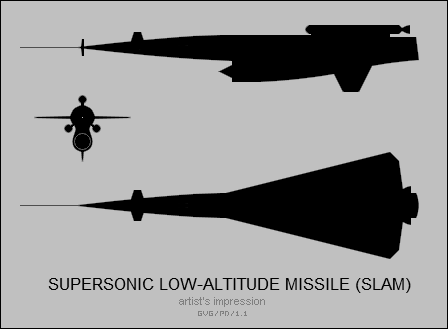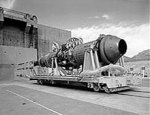SurvivalRing
Rich Fleetwood - Founder - author/coder/podcaster
I’ve watched a few videos of the Dark Footage channel, and came across this vid last night. The video talks about a nuclear powered missile developed by the Russians, that can fly forever, at speeds up to Mach 20.
Video was posted to yootuub yesterday. I recalled that the US worked on a similar project decades ago. Below is the history of that American self-preservation attempt.
Many years ago, the scientists of the USA developed their own nuclear missile project. It was called Project Pluto.
“The Supersonic Low Altitude Missile or SLAM was a U.S. Air Force nuclear weapons project conceived around 1955, and cancelled in 1964. SLAMs were conceived of as unmanned nuclear-powered ramjetscapable of delivering thermonuclear warheads deep into enemy territory. The development of ICBMs in the 1950s rendered the concept of SLAMs obsolete.
Advances in defensive ground radar also made the stratagem of low-altitude evasion ineffective. Although it never proceeded beyond the initial design and testing phase before being declared obsolete, the design contained several radical innovations as a nuclear delivery system.

Conceived role

Tory II-A

Tory II-C
The SLAM was designed to complement the doctrine of mutually assured destruction and as a possible replacement for, or augment to, the Strategic Air Command system. In the event of nuclear war it was intended to fly below the cover of enemy radar at supersonic speeds and deliver thermonuclear warheads to roughly 16 targets.
Innovations
The use of a nuclear engine in the airframe promised to give the missile staggering and unprecedented low-altitude range, estimated to be roughly 113,000 miles (182,000 km) (over 4.5 times the equatorialcircumference of the Earth).
Despite misinformed public opinion, the idea that the engine could act as a secondary weapon for the missile is not practical.[1][2] According to Dr. Theodore C. Merkle, the head of Project Pluto, in both his testimony to Congress and in a publication regarding the nuclear ramjet propulsion system, he reassures both Congress and the public of this fact.
[3][4]Specifically, he states "The reactor radiations, while intense, do not lead to problems with personnel who happen to be under such a power plant passing overhead at flight speed even for very low altitudes."[citation needed] In both documents, he describes calculations that prove the safety of the reactor and its negligible release of fission products compared to the background.
Along the same vein of these calculations, the missile would be moving too quickly to expose any living things to prolonged radiation needed to induce radiation sickness. This is due to the relatively low population of neutrons that would make it to the ground per kilometer, for a vehicle traveling at several hundred meters per second. Any radioactive fuel elements within the reactor itself would be contained and not stripped by the air to reach the ground.[citation needed]

 en.m.wikipedia.org
en.m.wikipedia.org
Russia's Most Secret Nuclear Missile Explodes? The Skyfall Accident
Russia's Most Secret Nuclear Missile Explodes? The Skyfall Accident
Dark Footage
57,042 views
Sep 24, 2021
The 9M730 Burevestnik Petrel, or SSC-X9 Skyfall, is a state-of-the-art Russian experimental nuclear-powered cruise missile.
The Skyfall is only one of six strategic weapons unveiled by President Vladimir Putin since March of 2018. Although not much is known about it, several sources claim that the missile has virtually unlimited range and lethal capabilities.
In August of 2019, the Russian nuclear agency Rosatom confirmed that the release of radiation at the Nyonoksa missile testing site near Severodvinsk was linked to an incident involving a classified missile. The incident became known as the Skyfall accident, as many experts and journalists believe the secret Russian missile was probably involved. --
- Dark Footage showcases the most unbelievable photos and videos from history while telling the stories behind the camera. Featuring military, space, aircraft and real-life historic events caught on tape.
View: https://youtu.be/jO6tKoM3zeg
Runtime = 9m, 52s
Video was posted to yootuub yesterday. I recalled that the US worked on a similar project decades ago. Below is the history of that American self-preservation attempt.
Many years ago, the scientists of the USA developed their own nuclear missile project. It was called Project Pluto.
“The Supersonic Low Altitude Missile or SLAM was a U.S. Air Force nuclear weapons project conceived around 1955, and cancelled in 1964. SLAMs were conceived of as unmanned nuclear-powered ramjetscapable of delivering thermonuclear warheads deep into enemy territory. The development of ICBMs in the 1950s rendered the concept of SLAMs obsolete.
Advances in defensive ground radar also made the stratagem of low-altitude evasion ineffective. Although it never proceeded beyond the initial design and testing phase before being declared obsolete, the design contained several radical innovations as a nuclear delivery system.

Conceived role

Tory II-A

Tory II-C
The SLAM was designed to complement the doctrine of mutually assured destruction and as a possible replacement for, or augment to, the Strategic Air Command system. In the event of nuclear war it was intended to fly below the cover of enemy radar at supersonic speeds and deliver thermonuclear warheads to roughly 16 targets.
Innovations
The use of a nuclear engine in the airframe promised to give the missile staggering and unprecedented low-altitude range, estimated to be roughly 113,000 miles (182,000 km) (over 4.5 times the equatorialcircumference of the Earth).
Despite misinformed public opinion, the idea that the engine could act as a secondary weapon for the missile is not practical.[1][2] According to Dr. Theodore C. Merkle, the head of Project Pluto, in both his testimony to Congress and in a publication regarding the nuclear ramjet propulsion system, he reassures both Congress and the public of this fact.
[3][4]Specifically, he states "The reactor radiations, while intense, do not lead to problems with personnel who happen to be under such a power plant passing overhead at flight speed even for very low altitudes."[citation needed] In both documents, he describes calculations that prove the safety of the reactor and its negligible release of fission products compared to the background.
Along the same vein of these calculations, the missile would be moving too quickly to expose any living things to prolonged radiation needed to induce radiation sickness. This is due to the relatively low population of neutrons that would make it to the ground per kilometer, for a vehicle traveling at several hundred meters per second. Any radioactive fuel elements within the reactor itself would be contained and not stripped by the air to reach the ground.[citation needed]

Supersonic Low Altitude Missile - Wikipedia
Russia's Most Secret Nuclear Missile Explodes? The Skyfall Accident
Russia's Most Secret Nuclear Missile Explodes? The Skyfall Accident
Dark Footage
57,042 views
Sep 24, 2021
The 9M730 Burevestnik Petrel, or SSC-X9 Skyfall, is a state-of-the-art Russian experimental nuclear-powered cruise missile.
The Skyfall is only one of six strategic weapons unveiled by President Vladimir Putin since March of 2018. Although not much is known about it, several sources claim that the missile has virtually unlimited range and lethal capabilities.
In August of 2019, the Russian nuclear agency Rosatom confirmed that the release of radiation at the Nyonoksa missile testing site near Severodvinsk was linked to an incident involving a classified missile. The incident became known as the Skyfall accident, as many experts and journalists believe the secret Russian missile was probably involved. --
- Dark Footage showcases the most unbelievable photos and videos from history while telling the stories behind the camera. Featuring military, space, aircraft and real-life historic events caught on tape.
Runtime = 9m, 52s






